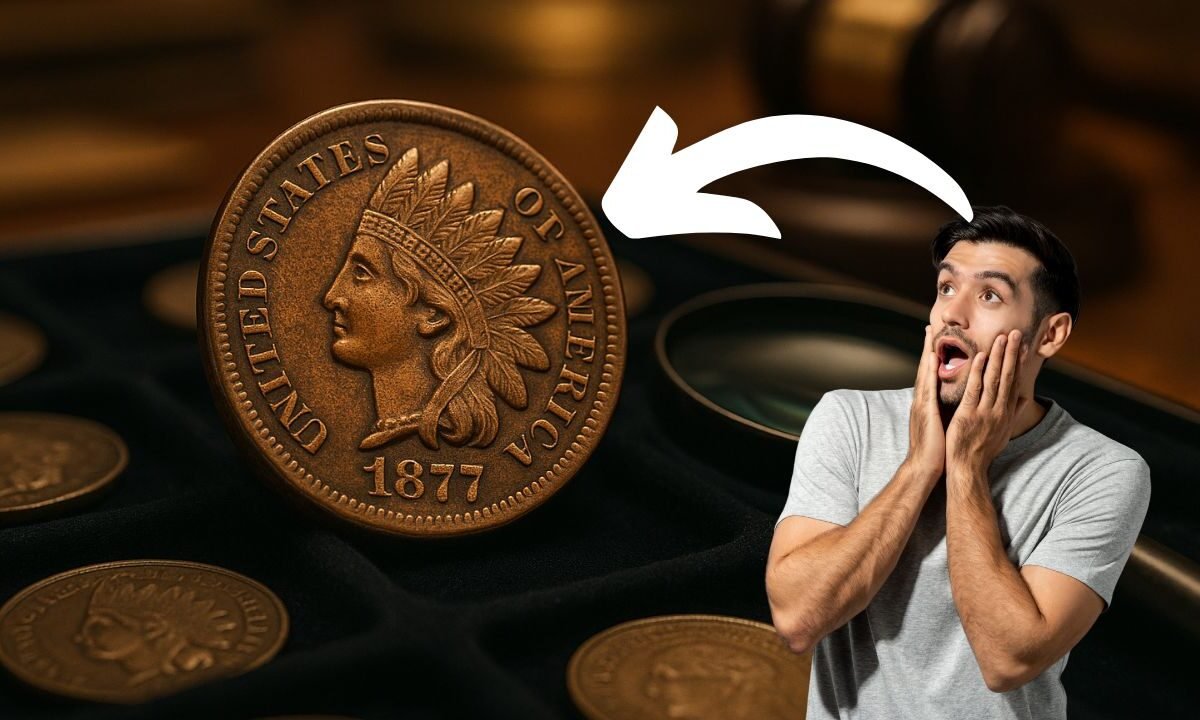The 1877 Indian Head Cent is the key date of the Indian Head series. Its low mintage and limited survival in nice condition keep prices strong across all grades.
Following the economic slowdown of the mid-1870s, the U.S. Mint produced far fewer small cents, and most of the 1877 coins went straight into circulation.
Very few were saved in high grade, which is why collectors still chase it today.
Quick Facts And 2025 Market Snapshot
| Attribute | Details |
|---|---|
| Type | Indian Head Cent (Bronze, Type 3) |
| Official Mintage | 852,500 (Philadelphia, no mint mark) |
| Likely Proof Output | Small, under ~1,000 pieces |
| Designer | James B. Longacre |
| Composition | 95% copper, 5% tin & zinc |
| Weight / Diameter | 3.11 g / 19 mm |
| Edge | Plain |
| Key Diagnostic | “Shallow N” in “ONE” on most business strikes (helps separate from Proof look and spot fakes) |
| Typical 2025 Value Range | $700–$1,300 in low grades; $1,500–$3,000 in mid grades; five figures in high-end Mint State, especially RB/RD color |
Note: Prices vary by grading service, eye appeal, and color designation (BN/RB/RD).
Understanding Rarity And Demand
- Low Output: With fewer than one million struck, this date is scarcer than most of the series.
- Circulation Wear: Most coins saw years of use, so problem-free Fine–Extremely Fine examples already command strong prices.
- Color Premiums: Bright Red (RD) pieces are rare and can bring five-figure prices; even attractive Red-Brown (RB) coins are highly contested.
How To Identify A Genuine 1877
Because values are high, counterfeits appear often. Use these quick checks before you buy:
- “Shallow N” Reverse: On genuine business strikes, the N in “ONE” looks shallower/softer than the N in “CENT.”
- Date Style: Watch for altered dates (e.g., 1887 changed to 1877). Compare the shape and spacing of the numerals carefully.
- Overall Detail: Many fakes show mushy lettering, odd portrait details, or wrong die characteristics.
- Certification Matters: Prefer coins authenticated and graded by PCGS or NGC to reduce risk.
Grade-By-Grade Price Context (2025)
- Good–Very Good (G–VG): Often $700–$1,300, depending on surfaces and originality.
- Fine–Very Fine (F–VF): Commonly $1,500–$2,200, rising for stronger detail or superior eye appeal.
- Extremely Fine (XF): Typically $2,200–$3,000+ for problem-free pieces.
- About Uncirculated (AU): Upper four figures are normal; premiums jump for RB/RD color and attractive luster.
- Mint State (MS): Five-figure results are achievable, especially MS-65 RB/RD and finer. Exceptional RD coins can approach $100,000.
Tip: Always compare apples to apples—same grade, same color (BN/RB/RD), similar eye appeal, and the same grading service.
Smart Buying Tips
- Buy The Coin, Not Just The Grade: Two coins with the same label can look very different. Prioritize eye appeal and originality.
- Certification First: For this key date, PCGS/NGC-certified examples are strongly preferred.
- Check The Reverse “N”: Confirm the Shallow N diagnostic on business strikes to avoid trouble.
- Budget Strategy: Many collectors target VF–XF as the sweet spot for detail vs. cost; investors with larger budgets pursue AU–MS RB/RD.
Care, Storage, And Resale
- Handling: Hold by the edges only; never clean. Cleaning destroys value.
- Storage: Use inert holders and stable, low-humidity environments to protect color.
- Resale: Keep grading certificates and receipts; documented provenance can add buyer confidence and help maximize returns.
The 1877 Indian Head Cent earns its legendary status through low mintage, limited survivors, and unmistakable diagnostics that reward knowledgeable buyers.
Whether you’re filling a set with a solid VF–XF or chasing a Mint State RD trophy, this date remains a blue-chip classic of U.S. copper—one that consistently attracts demand and premium pricing.
Do your homework, stick to certified coins, and let quality guide your choice.
FAQs
Why Is The 1877 Indian Head Cent Considered A Key Date?
Its low mintage and relatively few high-grade survivors make it the toughest date in the series, driving strong demand and premium prices.
What Is The Fastest Way To Spot A Fake?
Check for the “Shallow N” in “ONE,” examine the date numerals for alterations, and prefer coins certified by PCGS or NGC.
Which Grade Offers The Best Value For Collectors?
Many collectors choose VF–XF for an excellent balance of visible detail and affordability, saving AU–MS targets for larger budgets.

